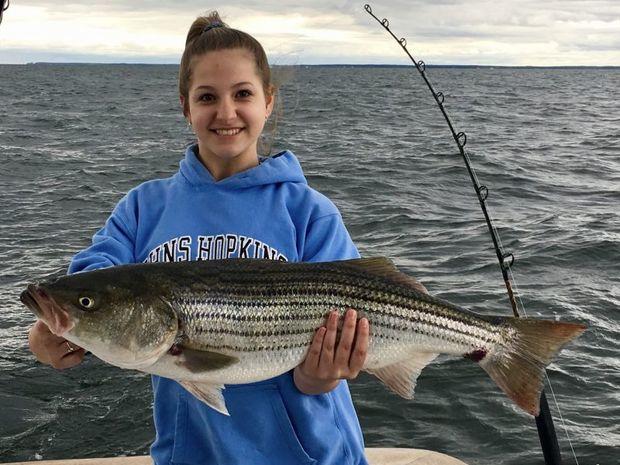Fish and shellfish can be an important part of a healthy diet, as they are good sources of high-quality protein and nutrients and are low in saturated fat. Many fish are safe to eat but some contain harmful chemicals, such as PCBs, that could be harmful if consumed, as outlined in the Maryland Fish Consumption Advisories. The Maryland Department of the Environment (MDE) monitors and evaluates contamination levels in fish, shellfish, and crabs throughout Maryland and issues guidelines for recreationally-caught fish.

The FDA and the EPA have also released national fish consumption guidelines (below) for pregnant women, women who may become pregnant, nursing mothers, and young children.
National Guidelines
- Do not eat shark, swordfish, king mackeral, or tilefish because they contain high levels of mercury.
- Eat up to 12 ounces (two average meals) a week of a variety of fish and shellfish that are lover in mercury.
- Five of the most commonly eaten fish that are low in mercury are shrimp, canned light tuna, salmon, pollock, and catfish.
- Albacore ("white") tuna has more mercury than light canned tuna. So, when choosing your two meals of fish and shellfish, you may eat up to six ounces (one average meal) of albacore tuna per week.
- Check local guidelines about the safety of fish caught by family and friends in your local lakes, rivers, and coastal areas. If no advice is available, eat up to six ounces (one average meal) per week of fish you catch from local waters, but don't consume any other fish during that week.
Maryland Guidelines (highlights)
*This is just a sampling of popular species that are consumed in the Bay and/or species/locations to be avoided. For the complete list of statewide fish consumption guidelines, click to the Maryland Department of the Environment.
Blue Crab
Specific recommendations for crab “mustard” have not been developed for all locations, however in general it is advised that the crab “mustard” from crabs taken from the Northern Chesapeake Bay (above Magothy River) should be consumed in moderation, while “mustard” from the below locations should be eaten sparingly, and avoided for the crabs from the Patapsco River/Baltimore Harbor.
- Crab "mustard" from crabs in the following locations contained elevated levels of PCBs and other contaminants.
- Cedar Creek, Fairlee Creek, Hart Miller Island, Middle River, Patapsco River/Baltimore Harbor.
Crab Meat: One meal equals nine crabs for general population and women (one crab for children).
- In Back, Middle, or Patapsco Rivers including Baltimore Harbor, recommended meals per month is six for general population and women, five meals for children.
- No restrictions for other areas of the Bay.
American Eel
American Eel caught in Back River, the Patapsco River/Baltimore Harbor, and the Susquehanna River below the Conowingo Dam should be avoided as they contain PCBs.
Striped Bass
The MDE notes that striped bass contain more than one gram of beneficial fatty acids in a fillet the size of two decks of cards. Striped bass in both the Chesapeake and its tributaries, as well as Maryland's Atlantic Coastal Waters contain PCBs.
Chesapeake Bay and Tributaries
- Fish greater than 28 inches in length: Recommendation is one meal per month for general population and women; one meal every other month for children.
- Fish less than 28 inches in length: Recommendation is three meals per month for general population and women; two meals per month for children.
Maryland's Atlantic Coastal Waters
- Recommendation is one meal per month for general population and women; one meal every other month for children.
Yellow Perch
Yellow perch caught in Middle River should be avoided by everyone.
White Perch
White perch caught in Middle River and the Mid Chesapeake Bay from Pooles Island to Bodkin Point should be avoided by children.